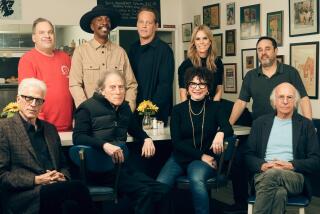Online Magazines on the Cutting-Edge
- Share via
When Michael Kinsley announced that he was leaving the media hothouse of Washington for Redmond, Wash., in late 1995, it was difficult to tell whose reaction was more fervid--his former colleagues in the establishment punditocracy, who gave him the print equivalent of a ticker-tape parade, or his new colleagues in cyberspace, who gave him the digital equivalent of a raspberry.
Kinsley, the former editor of the New Republic and co-host of CNN’s “Firing Line,” left the East Coast to create and edit Slate, an online magazine for Microsoft. Newsweek magazine thought his move was so noteworthy that they put him on the cover. Ken Auletta wrote a glowing, 14-page profile of Kinsley in the New Yorker. Even the Guardian in England was moved to publish a profile in which Kinsley was described as an “exceptionally talented journalist, one of the funniest, most acerbic and intellectually rigorous writers in America.”
Meanwhile, a writer in the Filter section of the already existing online magazine Feed--an “E-zine” or “Webzine” or just plain “ ‘zine”--wondered if Kinsley would be “consciously ripping off his predecessors with Slate” or if his suggestions about how Slate would improve on existing E-zines were simply “a sign of his genuine cluelessness.” Contributors to other E-zine sites variously attacked Kinsley as an arrogant elitist and as a tool of that capitalist pig Bill Gates.
Kinsley didn’t help himself any by declaring, in the very first issue of Slate, that there was “a deadening conformity in the hipness of cyberspace culture.”
More than a year later, many Netizens are still fulminating.
“Kinsley is like the English coming to Africa, saying they’re bringing civilization, taming the culture,” says Jon Katz of hotwired.com.
Kinsley now acknowledges that he had more to learn about Internet publishing than he had expected. He originally opposed using “links” in Slate to other stories and sites because he didn’t want to “clutter up our stories,” but he said the “youngest people on the staff fought for them” and he soon came to see their value. Slate stories now have links--but unlike most online publications, Slate puts its links at the end of each story rather than in the body of the story--much like using chapter notes instead of footnotes in a book.
Kinsley said he had also greatly underestimated the importance of archives--the ability of an online publication to keep back issues and stories available to users indefinitely.
If readers of print publications want to look at a story in an old issue, they usually have to go to the public library--and hope the copy isn’t gone. Online readers can find an old story--days old, weeks old, months old or even, in many cases, years old--with a click of their mouse.
Now that Slate has been publishing for more than a year, the most common criticism one hears is that while it may be very good, it is just a print magazine transferred to the Internet. Kinsley denies this--”We do multimedia and you can hear poetry read, see [televised] political ads and movie clips with our reviews”--but he also says, “Even if all you offered was the online equivalent of a print publication, it would be good because of the speed and the economies . . . the money you save on printing, paper and postage.”
Besides, there aren’t so many first-rate print magazines these days that Slate--which does consistently provide provocative cultural and political coverage and commentary--should be dismissed simply because it does not yet take full advantage of what Kinsley still calls the “bells and whistles” of Internet publication.
Slate has published a number of worthwhile articles, among them an investigative story last month that showed that Robert Reich, the former secretary of labor, misrepresented a number of episodes and confrontations in his book “Locked in the Cabinet.” Kinsley is also justly proud of a pointed exchange of views in Slate between Susan Estrich, a law professor and columnist, and Stuart Taylor, a writer for American Lawyer magazine, over Taylor’s contention that Paula Jones’ sexual harassment case against President Clinton is “far stronger than the media have let on--and far stronger than” Anita Hill’s case against Justice Clarence Thomas had been.
There are a growing number of intelligent magazines online. Although every major print magazine from People to Playboy has its own Web site now, the magazines created specifically for the Web generally offer the best reading, week in and week out (or should it be day in and day out, because some of these E-zines update their sites daily).
Online magazines such as HotWired, Feed, Word and IntellectualCapital routinely publish stories that are often sharper-edged and more thought-provoking than much of what appears in traditional magazines. But the E-zine that draws the most widespread praise is San Francisco-based Salon. In the four-month span from October 1996 to February 1997, U.S. News & World Report named Salon “cool site of the year,” Ad Age magazine named it “online magazine of the year” and Time magazine called it the best Web site of the year. Time said Salon “does everything right. It looks fresh and dramatic . . . and it features first-rate writers.”
David Talbott, the former arts and features editor of the San Francisco Examiner, started Salon in part because he missed his college days when “you could have intelligent conversations with other adults about books you’re reading” and in part because he found himself bored and annoyed by the mainstream media.
“Too many media companies don’t want to get wild and crazy and have a rollicking good time,” he says. “They’re becoming increasingly dumbed down . . . and celebrity-driven. I thought intelligence would be the next growth area. After all, how many stories can you read on Madonna?”
Talbott, the editor of Salon, considers the Internet a “quirky medium, in some ways more akin to talk radio” than to any other medium, and he likes to point not-so-gentle fun at Kinsley for having criticized the strong presence on the Net of so many untrained voices.
“Kinsley said he didn’t want to go to a restaurant and have the guy next to him cook dinner,” Talbott says. “Well, you have to let him cook one course.”
Toward that end, Salon--like most online sites--publishes a lively conversation section (“TableTalk”) in which readers, kibitzers and anyone else can voice their opinion on the contents of the site, the issues of the day or most anything else.
But Salon, which describes itself as both an interactive magazine and a “kinetic community,” has a staff that is a little older and more experienced than those at most of its competitors--and it shows in the content. Salon is heavy on reviews of books, music, movies and other art forms, but it also publishes news, weekly food and travel sections, offbeat media criticism (under the rubric Media Circus) and regular commentary from such well-known figures as writers Anne Lamott, Anne Rice, Camille Paglia and David Horowitz and political advisors James Carville and Mary Matalin.
Every two weeks or so, Salon publishes a (usually) thoughtful interview, mostly with writers--Joan Didion, Jamaica Kincaid, John le Carre, Salman Rushdie, Margaret Atwood--but also including dancer Bill T. Jones, actress Helen Mirren, filmmaker Mike Leigh and former California Gov. Edmund G. “Jerry” Brown Jr.
In May, Salon signed an agreement with United Features Syndicate to distribute its content to both print and online newspapers, and the Web site also initiated Brainwave, a joint online discussion with the staffs and readers of three other Web sites--Feed, Electric Minds and The Site--on a variety of issues. The first subject was libertarianism on the Net. The second is to be about the dominance of whites on the Net.
“The Web is a unique culture, a unique community,” Talbott says. “It’s also mostly white--so much so that it’s sometimes called the World White Web. We want to find issues like this that deserve a wider debate and elevate the discussion. We want to examine this and ask, “Does that lead to a one-dimensionality, a homogeneity that’s unhealthy?”
More to Read
The biggest entertainment stories
Get our big stories about Hollywood, film, television, music, arts, culture and more right in your inbox as soon as they publish.
You may occasionally receive promotional content from the Los Angeles Times.









